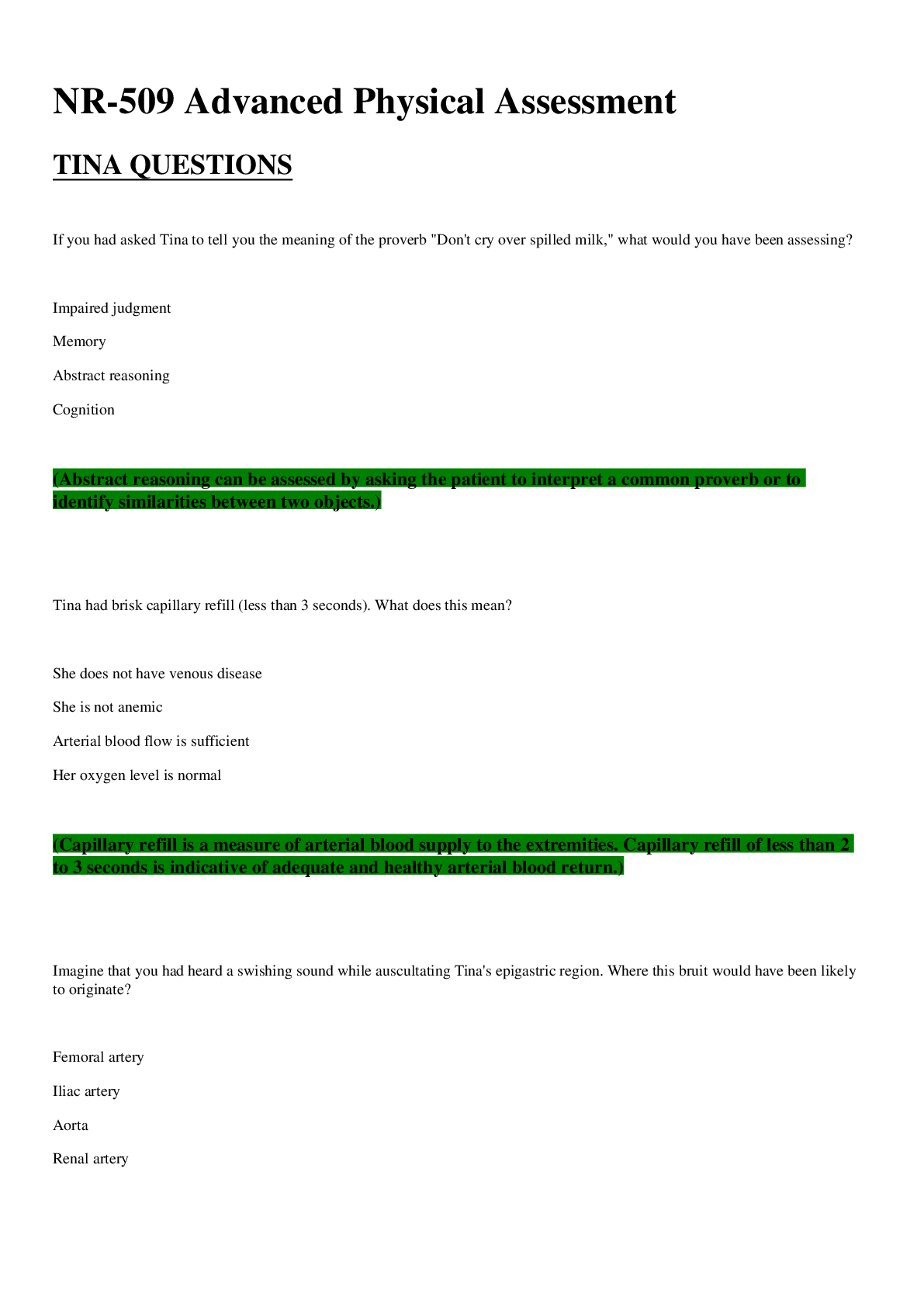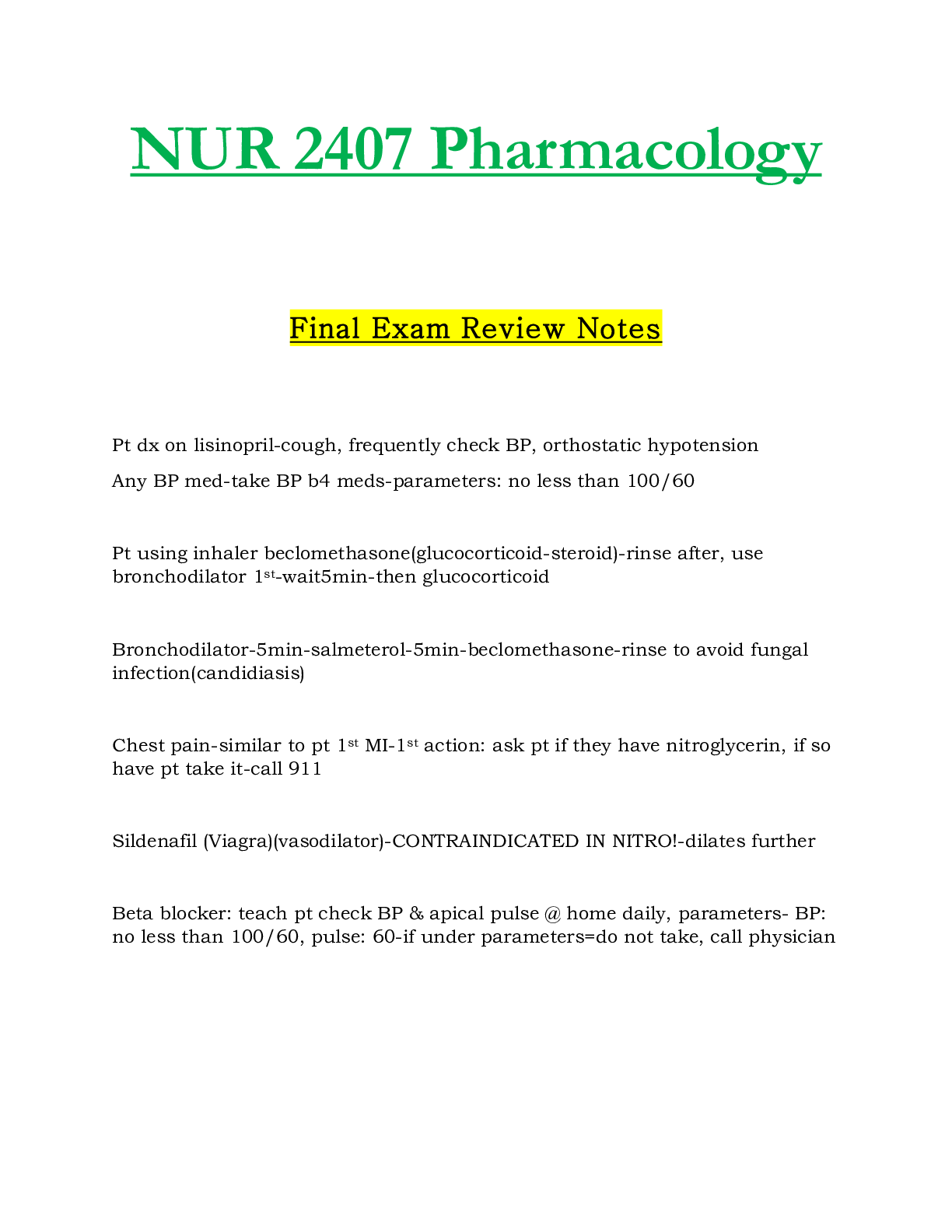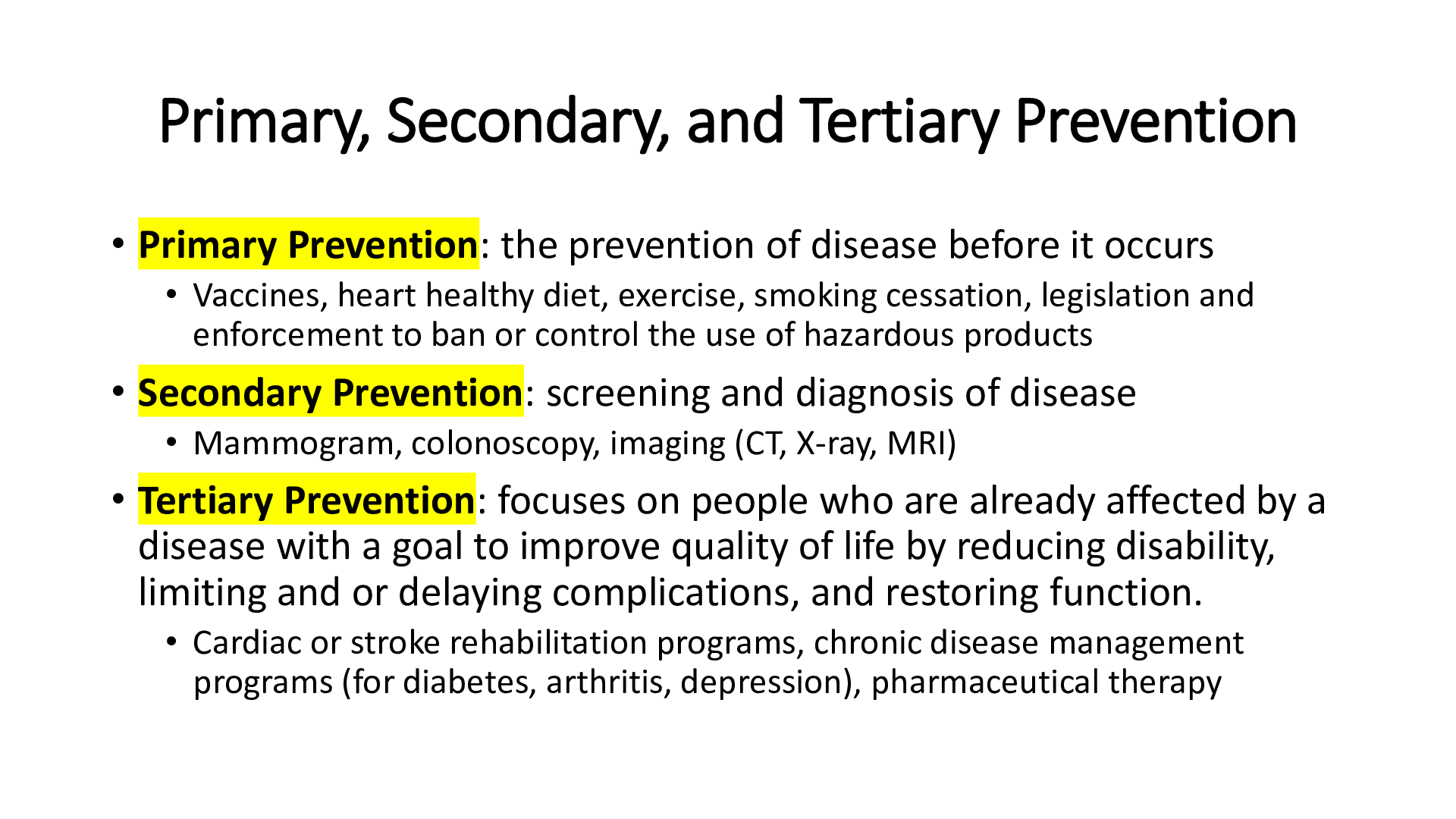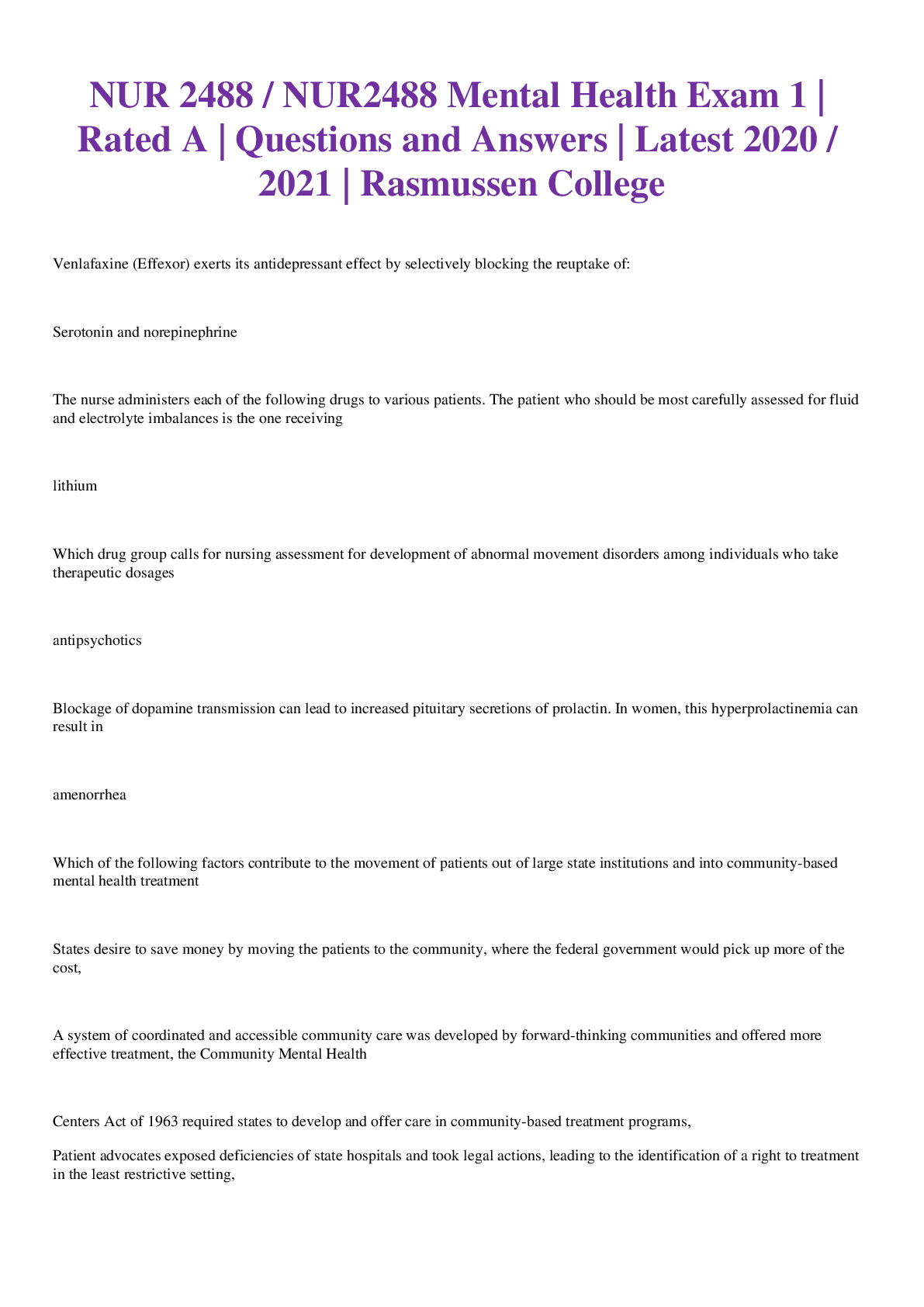*NURSING > EXAM REVIEW > NR509 / NR 509: Advanced Physical Assessment {TINA Questions & Answers with Rationale} Latest 2020 / (All)
NR509 / NR 509: Advanced Physical Assessment {TINA Questions & Answers with Rationale} Latest 2020 / 2021 - Chamberlain College Of Nursing
Document Content and Description Below
NR-509 Advanced Physical Assessment TINA QUESTIONS 1. If you had asked Tina to tell you the meaning of the proverb "Don't cry over spilled milk," what would you have been assessing? a) Impair... ed judgment b) Memory c) Abstract reasoning d) Cognition (Abstract reasoning can be assessed by asking the patient to interpret a common proverb or to identify similarities between two objects.) 2. Tina had brisk capillary refill (less than 3 seconds). What does this mean? a) She does not have venous disease b) She is not anemic c) Arterial blood flow is sufficient d) Her oxygen level is normal (Capillary refill is a measure of arterial blood supply to the extremities. Capillary refill of less than 2 to 3 seconds is indicative of adequate and healthy arterial blood return.) 3. Imagine that you had heard a swishing sound while auscultating Tina's epigastric region. Where this bruit would have been likely to originate? a) Femoral artery b) Iliac artery c) Aorta d) Renal artery 4. Which of the following physical exam tests could be used if you suspected cholecystitis in Tina? a) Rovsing's sign b) Rebound tenderness c) Murphy's sign d) McBurney's sign 5. Suppose that you were concerned that Tina may have had an enlarged spleen. How would you have proceeded? a) Palpate along the left costal margin b) Assess for bulging flanks c) Palpate for bulging flanks d) Percuss in the left anterior axillary line 6. Imagine that Tina has hard painless bumps on the dorsolateral aspects of the distal interphalangeal joints that had limit flexion during a range of motion test. How would you have documented these abnormalities? a) Heberden's node b) Bouchard's node c) Swan neck deformity d) Boutonniere deformity 7. In order to determine which heart sound is S1, which of the following should you assess? a) Apical pulse b) External jugular vein c) Internal jugular vein d) Carotid upstroke 8. The assessment of Jugular Venous Pressure (JVP) correlates with: a) Central venous pressure b) Left ventricular ejection fraction c) Left ventricular pressure d) Pulmonary artery pressure 9. A 29-year-old woman comes in with right sided abdominal pain. You suspect appendicitis. Which of the following maneuvers would not be used to rule in or rule out this diagnosis? a) Psoas sign b) Percussion for costovertebral tenderness c) Obturator sign d) Rosving's sign 10. During a gastrointestinal exam, the purpose of light palpation of the abdomen is to: a) Assess for tenderness b) Determine if deep palpation is needed c) Assess for abdominal masses d) Determine organomegaly 11. According to Bates, what is the correct order of the following steps in assessing a musculoskeletal complaint? 1. Is inflammation Present? 2. Is it intra- or extra-articular? 3. How many/which joints are involved? 4. Is it acute or chronic? 12. Ray works a physical job and notes pain when he attempts to lift his arm over his head. When you move the shoulder passively, he has full range of motion without pain and there is no gross swelling or tenderness. What type of joint disease does this most likely represent? a) Articular b) Non-Articular c) Both d) Neither 13. If you were assessing range of motion (ROM) for a healthy 28-year-old woman with no known joint issues, which of the following would indicate limited ankle ROM? a) 50 degrees plantar flexion b) 30 degrees plantar flexion c) 75 degrees dorsiflexion d) 50 degrees dorsiflexion 14. When palpating joints in a musculoskeletal exam, crepitus indicates: a) Roughened articular cartilages b) An effusion in the joint c) Articular injury d) Supporting muscles are contracted 15. Which of the following symptoms would not be a warning sign for stroke? a) Photophobia b) Severe headache c) Altered speech d) Altered motor function 16. With what condition might you find a delayed reaction when testing the ankle reflex? a) Central nervous system disease b) Peripheral nervous system disease c) Hypotension d) Hypothyroidism 17. A woman experiences syncope after hearing that her son was severely injured. She becomes pale and collapses to the ground without injuring herself. On waking, she states that she feels very warm. She denies any other symptoms. There are no findings on examination. What was the likely cause of her loss of consciousness? a) Micturition syncope b) Postural hypotension c) Vasovagal syncope 18. A patient comes to you because she is experiencing a tremor only when she reaches for things. This becomes worse as she nears the "target." When you ask her to hold out her hands, no tremor is apparent. What type of tremor does this most likely represent? a) Intention tremor b) Postural tremor c) Resting tremor d) Nervous tremor 19. To assess spinal levels L2, L3 and L4 in Tina, which deep tendon reflexes would have to be tested? a) Achilles b) Biceps c) Patellar d) Triceps 20. Suppose that Tina had been unable to identify the pen you were holding. What is the name of this symptom? a) Apraxia b) Discrimination loss c) Memory loss d) Agnosia 21. Which of the following is a component of assessing cognition? a) Memory b) Emotional response c) Speech d) Affect 22. Distinguish between inappropriate affect and appropriate affect, and provide an example of each. Affect - Appropriate affect is - Inappropriate affect is 23. Identify the components (domains) of a comprehensive mental status exam. - Comprehensive mental - Mental status assessment 24. Imagine that Tina's family member reported to you that she had been acting confused on and off for the last two days. Identify at least two key features of delirium. Describe why you would assess for delirium. 25. A light is pointed at a patient's pupil which contracts. It is also noted that the other pupil contracts as well though it is not exposed to light. Which of the following terms best describes this reaction? a) Direct reaction b) Consensual reaction c) Accommodation d) Near reaction 26. Which of the following tests is the assessment for lateralization of hearing loss? a) The Whisper Test b) The Finger Rub Test c) The Weber Test d) The Rinne Test 27. An 11-year-old presents with a sore throat, fever and fatigue for several days. You notice exudate on her enlarged tonsils. You do a careful lymphatic examination and notice some small, mobile lymph nodes just behind her sternocleidomastoid muscles bilaterally. What group of lymph nodes is this? a) Submandibular b) Tonsillar c) Occipital d) Posterior Cervical 28. Imagine that, during your physical exam with Tina, you had palpated an enlarged left supraclavicular lymph node. What would this finding have indicated? a) Nothing, because this is a normal variant b) A serious pathology c) A previous infection of the throat d) An active infection of the throat 29. If you had observed Arteriovenous (AV) nicking during the retinal exam on Tina, what would you have seen? a) Transparent arterial walls b) Opaque arterial walls c) Tortuous arteries and veins d) Vein stops on either side of the artery 30. You are listening to the lungs of a 17-year-old girl. You hear crackles and rhonchi but they clear with a cough, which of the following is the likely etiology? a) Bronchitis b) Simple asthma c) Cystic fibrosis d) Heart failure 31. An 81-year-old patient complains of shortness of breath for the past few days. On examination, you note vesicular breath sounds, normal fremitus and late inspiratory crackles in the lower third of the chest that were not present a week ago. What is the most likely explanation for these? a) Asthma b) COPD c) Bronchiectasis d) Heart Failure 32. If Tina had mentioned that she was just diagnosed with pneumonia, what would you have expected to find during percussion? a) Hyperresonance b) Tympany c) Resonant d) Dullness 33. If the results of Tina's pulse oximetry had been 97%, which of the following would have been true? a) Partial pressure O2 = 97% b) Unbound oxygen level = 97% c) PaO2 = 97% d) Arterial hemoglobin saturation = 97% 34. Suppose that, during your lung exam on Tina, you had heard bronchial breath sounds in the left lower lung posteriorly. What would you have suspected based on this finding? a) Normal lung exam b) Atelectasis c) Fluid filled region of the lung d) Narrowed upper airways secondary to asthma 35. A father brings his 11-year old to the clinic and describes that his son, who is normally "full of energy and constantly active" has been "exhausted and just sits around" for the last month or so. On exam, you hear a murmur only at the cardiac apex. Which valve is most likely to be involved, based on the location of the murmur? a) Mitral b) Tricuspid c) Aortic d) Pulmonic 36. An 80-year-old woman presents to your clinic with a complaint of breathlessness with activity. She has no chronic conditions and does not take any medications, herbs, or supplements. Which of the following symptoms would be a priority to ask about? a) Abdominal pain b) Orthopnea c) Hematochezia d) Tenesmus [Show More]
Last updated: 2 years ago
Preview 1 out of 10 pages

Buy this document to get the full access instantly
Instant Download Access after purchase
Buy NowInstant download
We Accept:

Reviews( 0 )
$10.00
Can't find what you want? Try our AI powered Search
Document information
Connected school, study & course
About the document
Uploaded On
Nov 15, 2020
Number of pages
10
Written in
Additional information
This document has been written for:
Uploaded
Nov 15, 2020
Downloads
0
Views
98



 JY21.png)











.png)










